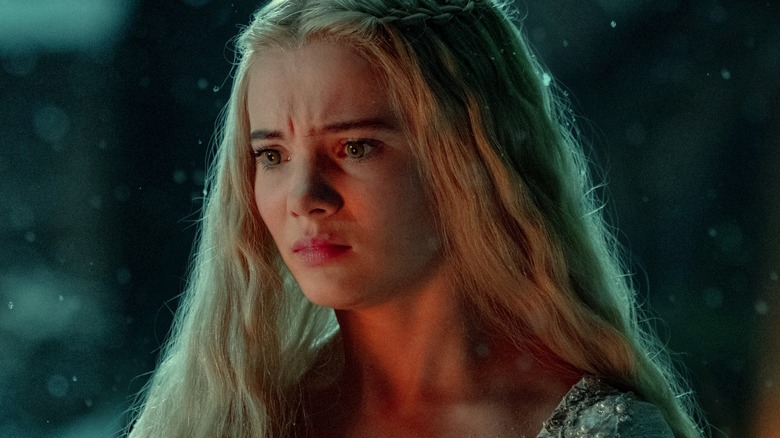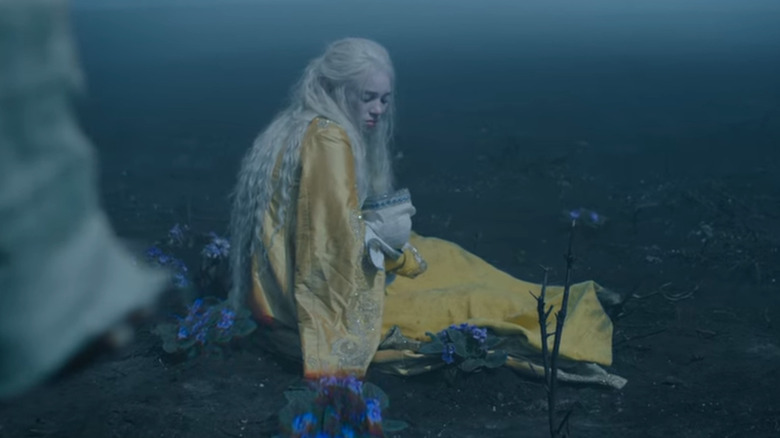
There's a lot of talk about Elder blood in "The Witcher" season 2, and specifically about how Ciri (Freya Allan) might be the "Child of Elder Blood," a prophesized mage with incredible power who will usher in a new era and deliver vengeance for the Elves.
There are many different kinds of magic in the world of "The Witcher," including that of the Witchers and the Chaos used by most mages. But what does it mean to have Elder blood, and how is that magic unique? Let's break down the genealogy behind the Continent's most powerful bloodline, which ends with Princess Cirilla, a talented mage who has already changed the course of history.
Warning: Minor spoilers for season 2 of "The Witcher" lie ahead!
From Lara To Ciri

"The Witcher" season 2 starts with Ciri and Geralt (Henry Cavill) stopping on the way to Kaer Morhen to stay with the cursed Nivellen (Kristofer Hivju) at his sprawling manor. He tells Ciri the story of "The Fall of the Elders," which follows a human man and Elven woman who fell in love, but both died shortly after their child was born. It's a sad story, but seems unrelated to our heroes until Ciri and Triss (Anna Shaffer) start exploring Ciri's past.
In episode 5, "Turn Your Back," Triss uses powerful magic to take herself and Ciri into Ciri's past, but the spell gets away from Triss. She loses control over the exploration and they're brought to a barren, burned field with a wounded Elven woman holding an infant. She's surrounded by the Feainnewedd flower, which is the same flower that grew where Ciri's blood fell in Kaer Morhen. The Elven woman is Lara Dorren, Ciri's ancestor who longed to unite the Elves and humans, but whose bitterness led her to curse humanity instead.
Elder blood is a mutant gene that was created by the Elves in an attempt to create a mage more powerful than any other, who could open doors between worlds. Lara was believed to be the last carrier of the gene, and many thought that Elder blood died out with her. Instead, our heroes discover that Ciri is descended from Lara, and her Elder blood has been activated by another carrier marrying into the family.
Tracking A Magical Lineage
Part of the reason that people thought the Elder blood gene had died out was because it needs to be "activated" by another dormant gene. Male carriers of Elder blood don't exhibit any special powers, but they can pass the gene on. To apply science from our world to it, the gene is probably carried on the X chromosome, but requires two of the gene in order to activate. Some XX folks carry the Elder blood on one X but not both, making them carriers without the power. XY carriers, likewise, do not exhibit powers. But when an XX carrier and an XY carrier have a child and the genetics line up correctly? You get Ciri, a.k.a. the Child of Elder Blood.
It's rare for high fantasy to involve any kind of scientific understanding, but the genealogy of "The Witcher" is complex and fascinating. Triss can identify the Elder blood gene through a simple blood test, and they take that Elder blood to create the potion that creates new Witchers. Magic and science work in tandem, bringing a richness to the world of "The Witcher."
With Ciri's identity and powerful bloodline exposed, at least we now know why everyone is so interested in capturing her.
"The Witcher" season 2 is now streaming on Netflix.
Read this next: 13 Fantasy Films That Never Got Sequels
The post The Significance of Elder Blood in The Witcher appeared first on /Film.
from /Film https://ift.tt/3pd1U3j
via IFTTT
Comments
Post a Comment